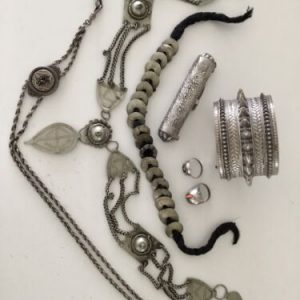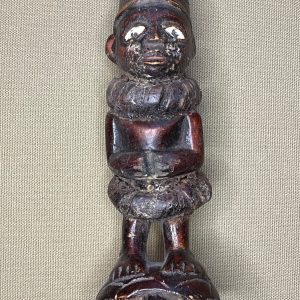Rare African dagger
$100.00
Rare African dagger. Antique dagger is 19” overall with a 13” double edge blade. Handle is a finely carved Anthropomorphic figure. Blade has some mild rust. Ethnic patter is engraved on one side of the blade. Sheath is decorated with circle burn marks on both sides. Sheath has some cracking and a hole on one side. It is held together with brass bands and is quite sturdy. Fine piece for anyone collecting African blades.
1 in stock
Related products
-

LOT OF VINTAGE JEWELRY SILVER FAMILY Berber TOUAREG ? Morocco
LOT OF VINTAGE JEWELRY SILVER FAMILY Berber TOUAREG ? Morocco. Vintage condition. Bracelet in good condition On Dec-14-22 at 10:39:40 PST, seller added the following information:7 pieces
$50.00 Add to cart -

Short Sword Mambeli Boa / Angba / Hanga, D.R. Congo
Short Sword Mambeli Boa / Angba / Hanga D.R. Congo Iron, wood, brass Early 20th century In addition to being a functional blade, the mambeli short sword served as a symbol of prestige and as currency. Most were carried under the belt without a sheath; examples with a sheath are rare. While their dimensions vary considerably—from 8 to 36 inches—the size of the handle is always relatively small. The mambeli short sword was produced in large quantities by the Boa (Ababua, Bobwa), Angba (including the Mongelima), and Hanga. They were also collected among numerous neighboring populations, including the Bandia, Zande, Mangbetu, Nzakara, Barambo, Mba, Ndaaka, Bati, Binja, and Bengé. Their popularity and widespread distribution resulted in innumerable local variants designed by neighboring peoples. The Boa migrated to their current homeland in northeastern D.R. Congo from the west, and arrived before the Bandia and Barambo migrated from the northwest, and the Mangbetu from the east. The Zande then arrived from the north and settled nearby. The Mangbetu, Zande, and Bandia exerted a preponderant influence on the Boa, particularly in their clothing, daggers, and shields. Despite this strong influence, the Boa remained independent (Elsen, De fer et de fierté, 2003). Mounted on a custom display stand. Free worldwide shipping. 19 in :: 48 cm
$199.00 Add to cart -

Small Congo Power Figure with Mirrored Compartment on Back – Standing on Turtle
This little power figure has an amazing patina from long use. He wears a typical Congo hat and has painted eyes. There is a very shiny plant fiber woven wrapping around his neck and his waist (you can see red fabric under the waist wrapping). He carries a mirrored compartment on his back. It looks like some kind of dripped or applied substance coming from the eyes, like tears. Approximately 6 1/4″ tall and 2 1/4″ wide at base from front. Sorry, no international buyers, shipping only to the USA.
$175.00 Add to cart -

Fine Antique Ashanti Doll, Ghana
Fine Antique Ashanti Doll, Ghana This highly stylised wooden doll is from the Ashanti, the largest sub-group of the Akan people. This doll demonstrates the carving skills of Ashanti carvers. The characteristic features of such dolls are a flat round disk-like head, a high forehead, annulated neck, outstretched arms and female sex. Such characteristics symbolised desirable traits for a woman in Ashanti society. The over-sized head symbolised intelligence. The roundness of the face symbolised beauty. Outstretched arms suggest generosity. They played multiple roles for an Ashanti girl: they served as playthings, were supposed to promote her fertility; and served as a protective charm during pregnancy. Often they were given to young Ashanti girls to promote their motherhood role. Caring for such dolls also was thought to promote fertility. Often such dolls were worn strapped to the back like a real infant. The dolls were consecrated by priests. Tradition has it that a woman, called Akua, was barren. She consulted a priest for advice. The priest suggested that she commission a carver to produce a small wooden child (dua ba). She then had to care for the wooden child as if it were her real baby. This she did, despite being mocked by the other women in the village. But, she had a beautiful daughter eventually. Thereafter, Ashanti women carried these dolls around to promote their fertility. Traditionally, Ashanti mothers preferred daughters. Ashanti society is matrilineal, which means a daughter will carry on the family name and inherit property. They would take extreme care during their pregnancies to avoid looking at anything ugly or deformed. They believe that the foetus may be affected by the view of ugly things. Therefore, by looking at the akuaba dolls (or plural akuamma), the expectant mothers imbue their foetus with the ideal of beauty. The doll here is in fine condition. It has excellent age and a lustrous patina. Dimensions: 12.5 ” H x 4″W Thank you for your interest in my curated selection of rare and unusual pieces! We have taken pride for over 20 years in our excellent reputation, and strive to satisfy our clients’ exact needs. Please note that we take great care in accurately describing our items, and we support that with a money back guarantee. If you receive a product that is not as described, we will promptly refund the cost once the item has been returned in good order. If you have any questions or require further images/information in order to make a decision please do not hesitate to contact us. Thanks and Best Regards, David Dixon and the Strange Imports Team
$365.00 Add to cart



Reviews
There are no reviews yet.